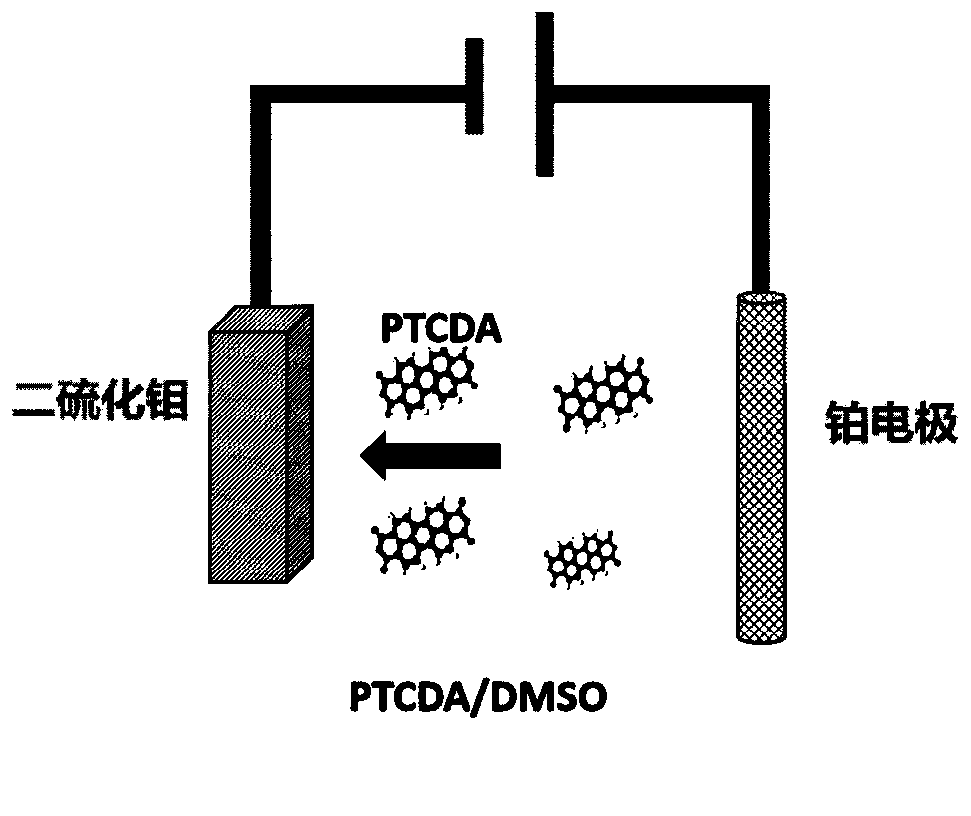Preparation method and application of organic-inorganic heterojunction
A heterojunction and heterostructure technology, which is applied in semiconductor/solid-state device manufacturing, molybdenum sulfide, electrical components, etc., can solve problems such as the inability to realize the preparation of organic-inorganic heterostructures, and achieve the elimination of contact barriers, easy operation, The effect of good contact
- Summary
- Abstract
- Description
- Claims
- Application Information
AI Technical Summary
Problems solved by technology
Method used
Image
Examples
Embodiment 1
[0030] In dimethyl sulfoxide (DMSO), add 3,4,9,10-perylenetetraacid dianhydride (PTCDA), stir and dissolve completely and then precipitate, take the upper saturated solution and centrifuge at 3000r, 3min to obtain a concentration of 1g / L PTCDA / DMSO solution.
[0031] Such as figure 1 , Take the molybdenum sulfide block and clamp it with the electrode holder, immerse it in the above solution, insert a platinum electrode and a calomel reference electrode in the solution, and apply a sweep from 0V to 3V between the platinum electrode and the molybdenum sulfide electrode Voltage, scanning speed 100mV / s, PTCDA is embedded in the molybdenum sulfide layer after scanning one circle. After the reaction, the surface of the original molybdenum sulfide block was cleaned with isopropanol to obtain PTCDA / MoS 2 Organic-inorganic heterojunction.
[0032] The performance characterization of organic-inorganic heterojunctions is as follows: Figure 2~4 . in, figure 2 for PTCDA / MoS 2 The ...
Embodiment 2
[0035] Adopt the method of the present invention to prepare molybdenum sulfide / PTCDA / molybdenum sulfide heterojunction, and use this organic-inorganic heterojunction as channel material to prepare molybdenum sulfide / PTCDA transistor, the preparation process is as follows Figure 5 .
[0036] (1) 275nm silicon (Si) / silicon dioxide (SiO 2 ) as the substrate, the bulk crystals were mechanically exfoliated to obtain a few-layer n-type molybdenum disulfide (MoS 2 ). The polymethyl methacrylate (PMMA) photoresist was spin-coated, the spin-coating parameter was 600r / min, 5s+4000r / min, 60s, and the baking parameter was 150°C for 10min. The photolithography and development of the electrode pattern were carried out by electron beam exposure (EBL), and the developing solution was MIBK:IPA=1:3, at room temperature for 45s. Electron beam evaporation (EBE, E-Beam Evaporation) is used to deposit 20nm Ti / 50nm Pd to obtain a contact electrode, and a back gate molybdenum sulfide field effect...
Embodiment 3
[0040] With reference to the method of Example 2, replace PTCDA with C60 and pentacene ("Pentacene"), replace molybdenum sulfide with tungsten sulfide and highly oriented pyrolytic graphite ("HOPG"), and prepare 9 kinds of organic compounds with different raw materials respectively. Inorganic heterojunction field effect transistors.
[0041] The transfer characteristic curves before and after intercalation of different organic-inorganic combined field-effect transistors (FETs) are as follows: Figure 9 , it can be seen that, in addition to WS 2 / Pentacene, it can be seen from the transfer curve that the switching ratio decreases, an obvious N doping is seen, and the current rises, that is, organic and inorganic heterostructures are realized in the field effect transistors prepared.
PUM
 Login to View More
Login to View More Abstract
Description
Claims
Application Information
 Login to View More
Login to View More - R&D
- Intellectual Property
- Life Sciences
- Materials
- Tech Scout
- Unparalleled Data Quality
- Higher Quality Content
- 60% Fewer Hallucinations
Browse by: Latest US Patents, China's latest patents, Technical Efficacy Thesaurus, Application Domain, Technology Topic, Popular Technical Reports.
© 2025 PatSnap. All rights reserved.Legal|Privacy policy|Modern Slavery Act Transparency Statement|Sitemap|About US| Contact US: help@patsnap.com



